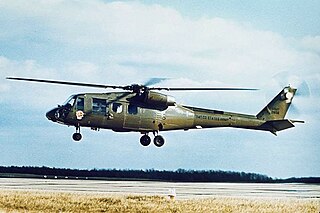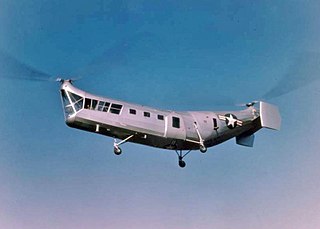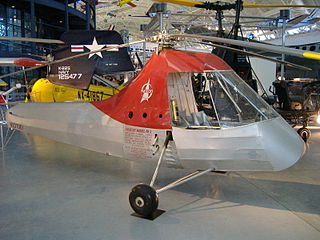
The Boeing Vertol CH-46 Sea Knight is an American medium-lift tandem-rotor transport helicopter powered by twin turboshaft engines. It was designed by Vertol and manufactured by Boeing Vertol following Vertol's acquisition by Boeing.

New York Airways was an American helicopter airline in the New York City area, founded in 1949 as a mail and cargo carrier. On 9 July 1953 it may have been the first scheduled helicopter airline to carry passengers in the United States, with headquarters at LaGuardia Airport. Although primarily a helicopter airline operator with scheduled passenger operations, New York Airways also flew fixed wing aircraft, such as the de Havilland Canada DHC-6 Twin Otter 19-passenger STOL twin turboprop aircraft.

The Piasecki H-21 Workhorse/Shawnee is an American helicopter, the fourth of a line of tandem rotor helicopters designed and built by Piasecki Helicopter. Commonly called "the flying banana", it was a multi-mission helicopter, capable of being fitted with wheels, skis or floats.

A tandem-rotor aircraft is an aircraft with two large helicopter rotor assemblies mounted one in front of the other in the horizontal plane. This configuration is mainly used for large cargo helicopters. Such aircraft are often informally referred to as "Chinooks," after the CH-47 Chinook, one of the first widely adopted heavy-lift helicopters with a tandem-rotor configuration.

The Piasecki HUP Retriever or H-25 Army Mule, later UH-25, is a compact single radial engine, twin overlapping tandem rotor utility helicopter developed by the Piasecki Helicopter Corporation of Morton, Pennsylvania. Designed to a United States Navy specification, the helicopter was produced from 1949 to 1954, and was also used by the United States Army and foreign navies. The HUP/H-25 was the first helicopter to be produced with an autopilot and also the first to perform a loop.

Frank Nicolas Piasecki was an American engineer and helicopter aviation pioneer. Piasecki pioneered tandem rotor helicopter designs and created the compound helicopter concept of vectored thrust using a ducted propeller.

The Bristol Type 192 Belvedere is a British twin-engine, tandem rotor military helicopter built by the Bristol Aeroplane Company. It was designed by Raoul Hafner for a variety of transport roles including troop transport, supply dropping and casualty evacuation. It was operated by the Royal Air Force (RAF) from 1961 to 1969. The Belvedere was Britain's only tandem rotor helicopter to enter production, and one of the few not built by Piasecki or Boeing.

The Piasecki Aircraft Corporation (PiAC) is a manufacturer of aircraft, principally advanced rotorcraft. It was founded by American vertical flight pioneer Frank Piasecki to develop compound helicopters and other advanced rotorcraft after he was ousted from the leadership of his first company, Piasecki Helicopter.

The Boeing Vertol YUH-61 was a twin turbine-engined, medium-lift, military assault/utility helicopter. The YUH-61 was the runner-up in the United States Army Utility Tactical Transport Aircraft System (UTTAS) competition in the early 1970s to replace the Bell UH-1 Iroquois helicopter. At the end of the flyoff program, Sikorsky Aircraft was awarded a contract to develop and build its UH-60A entry.

Dragoljub Kosta Jovanovich, also known under his pen name D. K. or "Gish" Jovanovich, was a Serbian-American helicopter designer, inventor, and pioneer in autogyro technology. Born in the Kingdom of Yugoslavia, he subsequently moved to the United States, living first in Philadelphia and later in southern California.

The Boeing Model 360 is an American experimental medium-lift tandem rotor cargo helicopter developed privately by Boeing to demonstrate advanced helicopter technology. The aircraft was intended as a technology demonstrator, with no plans to put the type into production, and many of its design features were carried onto other programs including the RAH-66 Comanche and V-22 Osprey. The sole prototype has been preserved and is a static exhibit at the American Helicopter Museum in West Chester, Pennsylvania.

The American Helicopter Museum & Education Center (AHMEC) is located at 1220 American Boulevard, West Chester, Pennsylvania, United States. The transport museum focuses on the history, science and technology of rotary wing aviation. The collection contains over 40 civilian and military, autogyros, convertiplanes and helicopters, including some early generation models. The museum also has an extensive research library, the Renzo Pierpaoli Memorial Library, which contains documents, artifacts, films, and memoirs that museum members can use.

The Piasecki HRP Rescuer is a United States tandem-rotor transport or rescue helicopter designed by Frank Piasecki and built by Piasecki Helicopter. The Piasecki PV-3 was adopted as the HRP-1 Rescuer by the United States Navy, United States Marine Corps, and United States Coast Guard. An improved PV-17 variant was later produced as the HRP-2. As one of the first transport helicopters in military service, the HRP-1 was capable of carrying two crewmen and 8–10 passengers or 2,000 lb. (907 kg) of cargo.

The Piasecki H-16 Transporter was a tandem-rotor transport or rescue helicopter designed by Frank Piasecki and built by Piasecki Helicopter. The prototypes were evaluated by the United States Air Force and Army, but the crash of the second test aircraft led to cancelling the project.

Classic Rotors is a flying aviation museum specializing in helicopters and other rotorcraft, located at Ramona Airport in Ramona, California, United States.

The Sikorsky XHJS-1, was developed by Sikorsky Aircraft to meet a Naval requirement for a utility helicopter. The XHJS-1 was not ordered into production and only two prototypes were built.

Frank Kozloski (1916–2003) was an aeronautical engineer who worked on early tandem rotor helicopters and was one of the founders of Piasecki Helicopter's.
Donovan Reese Berlin was an American military aircraft designer and aircraft industry executive. Among the many designs with which he is associated are the Curtiss P-36 Hawk, Curtiss P-40 Warhawk and Fisher P-75 Eagle. His name is "synonymous with the development of military aviation". He designed aircraft that were safe, rugged and "a pilot's joy."


















